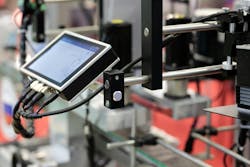The term human-machine interface (HMI) is evolving as automation advances and as technology in general advances. Really, the television, iPad and other similar devices are technically HMIs. However, for industrial automation, the HMI is typically for one machine, one point of access, and functionality for that machine.
Even if you refer to remote terminal units (RTUs) for rail systems or water systems or gas lines in rural Colorado, or the Black Sea, then the data is remote accessible over a supervisory control and data acquisition (SCADA) system. The HMI is a subcomponent of the SCADA system. If you have a robot cell and a palletizer with an HMI, it is not SCADA.
Attach the palletizing programmable logic controller (PLC) and HMI to a network and start grabbing material data for trending, then you may be gathering data for supervisory control. This is the traditional point of view.
However, what if you put your HMI on the network, take no data from it but allow it to be emulated on a cell phone and a person may walk the floor and read inputs. Is it called SCADA? Debatable, but the point that is being conveyed is this: HMIs are changing. Our definitions may also have to change, but, for now, it’s probably best to just ride it out before being attacked by some other acronym.
With that in mind, let’s look at the evolution of an HMI.
- Mechanical era: HMIs were a panel of mechanical buttons, gauges and doodads. Liquid-level gauges had numbers and ullage with a float. There also used to be chart recorders on ovens or furnaces that required you to load paper.
- Electrification: With advancements in electrical engineering, electrified interfaces emerged. Nameplates and buttons with switches or push buttons were groovy. For instance, hand/off/auto is a popular switch for pumps.
- Electronics integration: Chips and circuit boards allowed a screen to be made with indications and numbers. These included monochrome, symbolized data screens.
- Computerization: The advent of computers led to the computerization of HMIs.
- Mobile revolution: Mobile devices and touchscreens now allow technicians to walk the plant floor and gather vibration data from motors or pressure and flow from devices via Bluetooth or wireless networks.
- Natural interfaces: Emerging trends like enterprise IoT and Industry 4.0 continue to shape HMIs, moving toward more intuitive and natural interfaces.
- Robots: Robots could become human-machine interfaces in the future because some robots are better equipped to sustain hazardous environments than humans.
The main trend currently is the onset of HMIs in the cloud or remote to the operations on a server. This is an expansion of the SCADA and the evolution of the HMI software to allow for data collection, display and control in one package.
The onset of Open Platform Communications (OPC) was a turning point for machine interface that allowed data to be transferred more freely on more than one type of platform. The HMI became unbound to the programmable logic controller. This means traditional machine builders had options like distributed interfaces, which system integrators had always had: putting the HMI in a control room or upstairs or remote.
Perhaps this is why Industry 4.0 is a bit overwhelming at times, because the options are truly endless. The deciding factor should be based on application, and end-user needs. Considering the expected system outcomes allows the machine interface to be efficient and utilized correctly. Sometimes, the simpler interfaces are better. They are also cheaper. This is why integration suppliers give options at different technical complexities and price points. Also, operators may have gloves, and a screen may not last. Designing in context is key.
When creating an HMI from scratch, consider the following questions:
- What does the HMI need to do?
- What is important to the operation?
- What is easiest for the operator?
- How big does the HMI need to be?
- Does the HMI need to be connected to a local network or a system network?
- Does the HMI need to collect data?
- Will this HMI be part of a bigger machine system or single machine?
- Is the environment caustic to computers?
- What is the budget?
- Is the software easy or complicated?
- Is the proposed interface maintainable by the customer?
These are points to consider when creating an HMI. Also, do not forget the history of interfaces. Why? There is a time for basic and a time for complex. There is no rule saying that a gauge must be digitalized. The old design adage, “Keep it simple, stupid” (KISS) still applies; otherwise, it may no longer be a “human” machine interface.
About the Author
Tobey Strauch
Arconic Davenport
Tobey Strauch is currently managing brownfield installations for controls upgrades at Arconic Davenport. She has previously worked as principal controls engineer and before getting her bachelor’s in electrical engineering, was a telecommunications network technician. She has 20 plus years in automation and controls. She has commissioned systems, programmed PLCs and robots, and SCADAs, as well as managed maintenance crews. She has a broad mix of mechatronics with process control. She enjoys solving problems with Matlab and Simscape. Contact her at [email protected].
Sign up for our eNewsletters
Get the latest news and updates

Leaders relevant to this article:

